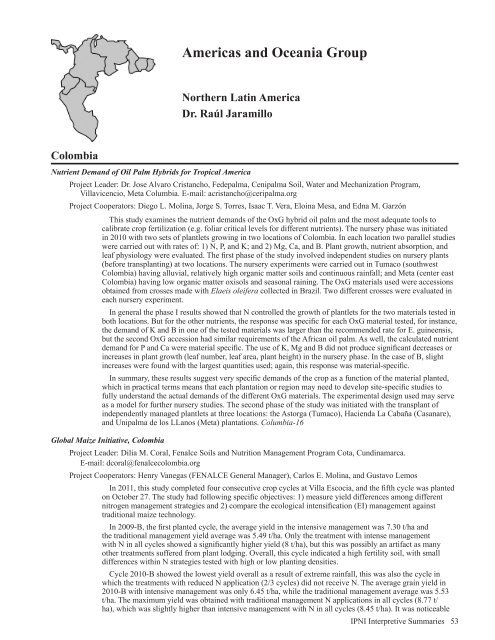Americas and Oceania Group - International Plant Nutrition Institute
Americas and Oceania Group - International Plant Nutrition Institute
Americas and Oceania Group - International Plant Nutrition Institute
Create successful ePaper yourself
Turn your PDF publications into a flip-book with our unique Google optimized e-Paper software.
<strong>Americas</strong> <strong>and</strong> <strong>Oceania</strong> <strong>Group</strong><br />
Northern Latin America<br />
Dr. Raúl Jaramillo<br />
Colombia<br />
Nutrient Dem<strong>and</strong> of Oil Palm Hybrids for Tropical America<br />
Project Leader: Dr. Jose Alvaro Cristancho, Fedepalma, Cenipalma Soil, Water <strong>and</strong> Mechanization Program,<br />
Villavicencio, Meta Columbia. E-mail: acristancho@ceripalma.org<br />
Project Cooperators: Diego L. Molina, Jorge S. Torres, Isaac T. Vera, Eloina Mesa, <strong>and</strong> Edna M. Garzón<br />
This study examines the nutrient dem<strong>and</strong>s of the OxG hybrid oil palm <strong>and</strong> the most adequate tools to<br />
calibrate crop fertilization (e.g. foliar critical levels for different nutrients). The nursery phase was initiated<br />
in 2010 with two sets of plantlets growing in two locations of Colombia. In each location two parallel studies<br />
were carried out with rates of: 1) N, P, <strong>and</strong> K; <strong>and</strong> 2) Mg, Ca, <strong>and</strong> B. <strong>Plant</strong> growth, nutrient absorption, <strong>and</strong><br />
leaf physiology were evaluated. The first phase of the study involved independent studies on nursery plants<br />
(before transplanting) at two locations. The nursery experiments were carried out in Tumaco (southwest<br />
Colombia) having alluvial, relatively high organic matter soils <strong>and</strong> continuous rainfall; <strong>and</strong> Meta (center east<br />
Colombia) having low organic matter oxisols <strong>and</strong> seasonal raining. The OxG materials used were accessions<br />
obtained from crosses made with Elaeis oleifera collected in Brazil. Two different crosses were evaluated in<br />
each nursery experiment.<br />
In general the phase I results showed that N controlled the growth of plantlets for the two materials tested in<br />
both locations. But for the other nutrients, the response was specific for each OxG material tested, for instance,<br />
the dem<strong>and</strong> of K <strong>and</strong> B in one of the tested materials was larger than the recommended rate for E. guineensis,<br />
but the second OxG accession had similar requirements of the African oil palm. As well, the calculated nutrient<br />
dem<strong>and</strong> for P <strong>and</strong> Ca were material specific. The use of K, Mg <strong>and</strong> B did not produce significant decreases or<br />
increases in plant growth (leaf number, leaf area, plant height) in the nursery phase. In the case of B, slight<br />
increases were found with the largest quantities used; again, this response was material-specific.<br />
In summary, these results suggest very specific dem<strong>and</strong>s of the crop as a function of the material planted,<br />
which in practical terms means that each plantation or region may need to develop site-specific studies to<br />
fully underst<strong>and</strong> the actual dem<strong>and</strong>s of the different OxG materials. The experimental design used may serve<br />
as a model for further nursery studies. The second phase of the study was initiated with the transplant of<br />
independently managed plantlets at three locations: the Astorga (Tumaco), Hacienda La Cabaña (Casanare),<br />
<strong>and</strong> Unipalma de los LLanos (Meta) plantations. Columbia-16<br />
Global Maize Initiative, Colombia<br />
Project Leader: Dilia M. Coral, Fenalce Soils <strong>and</strong> <strong>Nutrition</strong> Management Program Cota, Cundinamarca.<br />
E-mail: dcoral@fenalcecolombia.org<br />
Project Cooperators: Henry Vanegas (FENALCE General Manager), Carlos E. Molina, <strong>and</strong> Gustavo Lemos<br />
In 2011, this study completed four consecutive crop cycles at Villa Escocia, <strong>and</strong> the fifth cycle was planted<br />
on October 27. The study had following specific objectives: 1) measure yield differences among different<br />
nitrogen management strategies <strong>and</strong> 2) compare the ecological intensification (EI) management against<br />
traditional maize technology.<br />
In 2009-B, the first planted cycle, the average yield in the intensive management was 7.30 t/ha <strong>and</strong><br />
the traditional management yield average was 5.49 t/ha. Only the treatment with intense management<br />
with N in all cycles showed a significantly higher yield (8 t/ha), but this was possibly an artifact as many<br />
other treatments suffered from plant lodging. Overall, this cycle indicated a high fertility soil, with small<br />
differences within N strategies tested with high or low planting densities.<br />
Cycle 2010-B showed the lowest yield overall as a result of extreme rainfall, this was also the cycle in<br />
which the treatments with reduced N application (2/3 cycles) did not receive N. The average grain yield in<br />
2010-B with intensive management was only 6.45 t/ha, while the traditional management average was 5.53<br />
t/ha. The maximum yield was obtained with traditional management N applications in all cycles (8.77 t/<br />
ha), which was slightly higher than intensive management with N in all cycles (8.45 t/ha). It was noticeable<br />
IPNI Interpretive Summaries 53

















